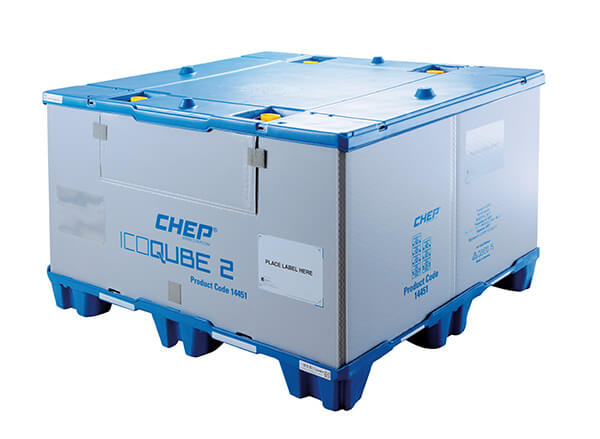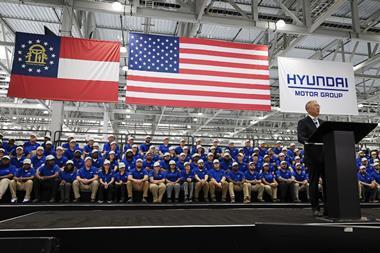CHEP has launched a strategy to support the digital transformation of its offerings and of the automotive supply chain, including vehicle electrification and tracking packaging assets
CHEP’s core business is all about managing and owning reusable packaging assets. Providing that service for its customers takes away the pain and hidden costs of running the service themselves, while giving them control and visibility of their inventory throughout the supply chain. That service is going to become all the more important according to Murray Gilder, CHEP’s vice-president of automotive in the EMEA region, as the automotive industry goes through the largest revolution in its history.
Cars driven by combustion engines are increasingly going to be replaced by hybrid and electric cars. While they only currently make up around 7% of global assembly that is set to climb to more than 20% by 2024, according to PwC Autofacts, helped by environmental legislation in regions including Europe and China.
This move to battery-electric driven vehicles will require new supply chain solutions and innovation, says Gilder, but the sector is still nervous about how to deal with the unknown, including battery logistics, and there are new players entering the market. This in itself is changing the rules of the game.
For Gilder that means CHEP has to change to meet the needs of its customers. To do that it needs to think outside the box, says Gilder, and tap into other resources and ideas to help those customers transform their businesses.
“If we want to stay relevant in the future market landscape we need to lead the supply chain transformation,” he says. “If we think that we can keep serving the market in the same ways we did in the past, we will be left behind.”
Transformation strategy
To do that CHEP launched its ‘Be a Transformer’ strategy in June 2018 and Gilder says the company has made significant progress.
 “As with most traditional businesses we have some areas to fix in terms of how we operate, but when we look at the potential this business has to make a significant impact on supply chains across the world, I feel like a kid in a candy shop,” says an optimistic Gilder.
“As with most traditional businesses we have some areas to fix in terms of how we operate, but when we look at the potential this business has to make a significant impact on supply chains across the world, I feel like a kid in a candy shop,” says an optimistic Gilder.
In preparation for the launch of Be a Transformer, CHEP held a three-day strategy workshop to look at its business and what was happening in the market, as well as uniting the team to speak with one voice.
“We knew we had to change the culture first before we could implement any kind of strategy,” says Gilder. “We therefore elected and adopted a new set of behaviours, which we live and breathe as the example to our people.”
Dangerous goods
The strategy has already had tangible results. CHEP’s solutions team has been working to obtain UN certification for dangerous goods packaging for foldable large containers.
This happened in preparation for the movement of lithium-ion (Li-Ion) batteries, which are demarcated as Class 9 dangerous goods under the UN Model regulation for the Transport of Dangerous Goods.
Gilder recognises that established carmakers and suppliers, and new players such as electronics firms LG and CATL, are more focused on the technological side of the battery but says logistics will become the biggest headache for all parties as the volumes peak in the very near future.
“We need to think ahead for our customers and try and raise awareness of the total cost of ownership for shipping Li-Ion at scale in cardboard, which is the norm today,” says Gilder.
“This is certainly not a sustainable solution – the UN certified cardboard is extremely expensive as a one-way use. The risk of damage and lack of transport utilisation will also be high with such solutions. The only real shot at creating a sustainable, scalable packaging solution is to have it shared and reused across the various supply chains.”
 Digitising the supply chain
Digitising the supply chain
CHEP is also working on the technology to manage the movement of containers through its sister company BXB Digital, whose objective is to digitise the supply chain.
“As a whole, our company has access to millions of touchpoints in the supply chain – we are working on how to bring value to our customers through data interpretation that delivers tangible value to them.”
In the EMEA region, CHEP’s central supply chain team based in the Spanish capital, Madrid, works with sophisticated planning systems, which analyse historical, current and expected demand from existing and new business flows.
“Almost all our customers use our portal to place their orders for both delivery and collections of a variety of products, in line with their demand from their customers,” explains Gilder. “We also encourage the use of EDI to stabilise the demand patterns across the supply chains.”
Standards for balance
Gilder admits that there are challenges in ensuring its fleet of products are pooled in the right way and aims to minimise the extent to which it has to rebalance the network, which is why it encourages standardisation of products where necessary.
“For example, when we look at intercontinental flows, this challenge is even greater,” he explains. “We did an analysis of our network recently and actually removed a product from the suite as it was an outlier.”
However, he sees more potential applications for the technology to digitise the supply chain. “The opportunities are enormous so we are focusing on building solutions for the critical few where we believe information along such supply chains will help our customers make intelligent decisions,” says Gilder.
 CHEP’s business model is about sharing the millions of containers it has across its supply chains and Gilder describes the company as “agnostic” when it comes to the actual packaging equipment. It partners to develop products together with well-known producers including Macro Plastics and Schöller Allibert. That approach creates economies of scale and supply chain visibility for the benefit of everyone involved, according to Gilder, but it also gives CHEP a unique view on how packaging supply chains work.
CHEP’s business model is about sharing the millions of containers it has across its supply chains and Gilder describes the company as “agnostic” when it comes to the actual packaging equipment. It partners to develop products together with well-known producers including Macro Plastics and Schöller Allibert. That approach creates economies of scale and supply chain visibility for the benefit of everyone involved, according to Gilder, but it also gives CHEP a unique view on how packaging supply chains work.
“Our expertise lies in our solutioning skills from both a packaging engineering perspective but also from a supply chain solution perspective,” says Gilder. “Transport collaboration, for example, is the future for sharing capacity and savings costs for all parties. We already do that with customers as we have visibility of many supply chains where capacity opportunities lie, as opposed to just a singular view that any one company has of their own supply chain.”
CHEP is able to leverage that insight for the benefit of the automotive industry (and the other sectors it serves). Gilder is clear that the more the industry learns about the cost of packaging associated with the inbound supply chain – from piece price, part damage, transport utilisation (or lack thereof), administration costs, and waste disposal (of cardboard) – the more the industry is taking note and recognising the hidden cost of packaging assets.
For more information: www.chep.com

























![Global[1]](https://d3n5uof8vony13.cloudfront.net/Pictures/web/a/d/s/global1_726550.svgz)













